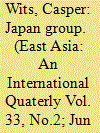|
|
|
Sort Order |
|
|
|
Items / Page
|
|
|
|
|
|
|
| Srl | Item |
| 1 |
ID:
145663


|
|
|
|
|
| Summary/Abstract |
‘Come, Make in India’, India’s Prime Minister has invited global firms to invest and manufacture in India and also to promote exports. As with this campaign, India has given a scope of promising growth to the companies which is also been seen to solve India’s multiple economic problems. Many countries have shown their interest to invest in India and one of them is South Korea. Now the question arises whether companies from South Korea in this competitive environment can mark their presence in India—a nation of cultural diversity, which can affect the initial start-ups, if ignored. Apart from the historical cultural ties, there are cross-cultural differences between South Korea and India. So, this paper aims to build up a study that brings together the parity and cross-cultural differences between South Korea and India. The paper opens with the discussion about the various historical, cultural and poetic relations to describe the scenario between the two countries, whereas for the analysis, a macro-meso-micro framework has been used to answer the research question. The three-level analysis helps this paper to see the overlooked influence of culture from a broader perspective. The results of the study reveal a list of cultural adaptations suited for South Korean start-ups to run businesses in India by avoiding the cultural threats and contribute to the existing literature. The study findings could be used by companies, marketers and practitioners to devise and re-vamp their strategies in India, and it will also serve as a cultural guide for them.
|
|
|
|
|
|
|
|
|
|
|
|
|
|
|
|
| 2 |
ID:
145659


|
|
|
|
|
| Summary/Abstract |
This article examines the Party-State-led Countryside Confucianism experiment based in the rural vicinities of Qufu. There has been, since the 1980s, a renewed interest in Confucianism from both mainland and foreign scholars. More academic to begin with, the focus has recently shifted toward more local and popular groups spreading Confucian teachings across the People’s Republic. This popular resurgence, often described as disjointed and fragmented, has sometimes expressed a more religious or politically charged Confucianism. Recent developments in the Shandong province are now pointing to a more organized—through the involvement of the Party-State—local revival. I argue that this recent government involvement in local Confucian revival comes as a way to compete and reposition itself on the local “cultural market” in order to reinstate its cultural authority over Confucianism, to curb certain practices and possibly restrain the growth of foreign beliefs in the Confucian city of Qufu. This objective of the article is first to document this countryside experience as to frame it in the more general Confucian revival. Furthermore, it will examine its ties to previous rural experiences conducted in Shandong as well as some of its more indirect sociopolitical objectives. To a certain extent, understanding this Party-State-led organized form of local Confucianism will shed light on its renewed role in terms of cultural authority, cultural governance, and local Confucian revival.
|
|
|
|
|
|
|
|
|
|
|
|
|
|
|
|
| 3 |
ID:
145660


|
|
|
|
|
| Summary/Abstract |
In the new Cold War context of the early 1950s, when the People’s Republic of China and Japan had no official relations, Chinese Premier Zhou Enlai developed his so called People’s Diplomacy; a strategy of creating informal channels between China and Japan that could serve to build a network of personal ties outside the immediate government sphere, ties that would ideally become so strong they would result in official diplomatic relations. A central position in this strategy was reserved for the Japan Group; an unofficial network drawn from different foreign policy organs, centered on Zhou Enlai’s close confidant Liao Chengzhi, which was to manage Zhou’s Japan policy. This group, many of whom had a background in intelligence work, was charged with training the Chinese government’s Japan specialists, managing all interactions with Japanese, as well as with actively cultivating ties with a wide variety of Japanese, especially outside of Japanese leftist circles. This article traces the establishment and inner workings of the Japan Group in the 1950s, based on published records of, and interviews with, group members. The main focus is on the core of the group, made up of a small number of trusted Japan hands around Liao Chengzhi. Since this same core group of people was involved in all interaction with Japanese, they provided the continuity necessary for cultivating the informal personal ties that had to lead to the long-term goal of Sino-Japanese rapprochement. This networking process, which transcended the immediate concerns of particular negotiations and exchanges, will also be explored.
|
|
|
|
|
|
|
|
|
|
|
|
|
|
|
|
| 4 |
ID:
145662


|
|
|
|
|
| Summary/Abstract |
Ever since Deng Xiaoping’s visit to Singapore in 1978, Beijing has showed tremendous interest in modeling Singapore on various aspects of domestic governance. This article seeks to locate China’s interest in learning from Singapore in the style of governance typified by Lee Kuan Yew, Singapore’s founding father. This article explores the domestic aspects of governance that are common to both countries and seeks to explain China’s interests toward Singapore in as far as it views Singapore as a model of efficient and effective government. This is seen in three key areas, namely, the strength of Singapore’s first-generation political leadership, the stability of the ruling party and consequently the country, and Singapore’s economic growth.
|
|
|
|
|
|
|
|
|
|
|
|
|
|
|
|
| 5 |
ID:
145661


|
|
|
|
|
| Summary/Abstract |
In the post–Cold War era, Japan has developed its own version of peacebuilding in concept and practice and has taken a non-coercive approach to peacebuilding. It has been underpinned by domestic norms of pacifism. This article elaborates on the underexplored theme of Japan’s peacebuilding by focussing on its conceptual basis and three key dimensions of practice. It aims at providing a refined understanding of the Japanese version of peacebuilding, which encompasses highly comprehensive activities in and beyond troubled regions, while carefully excluding the role of military coercion. This article first presents a brief overview of the term ‘peacebuilding’ understood internationally. It then examines Japan’s understanding of the concept of peacebuilding. It consists of the ‘consolidation of peace’ as an immediate contribution to peace and human security, and ‘state-building’ as establishing and enhancing political, economic and social frameworks for durable peace in the long run. The third section of this article investigates three important dimensions of Japan’s peacebuilding practice: (1) the on-the-ground effort in troubled regions consisting of non-military peacekeeping and the provision of foreign aid; (2) taking leadership in developing principles of, and approaches to, peacebuilding in international forums; and (3) human resource development for fostering civilian peacebuilders at home. Finally, this article concludes that Japan is carving out its niche in the field of peacebuilding, suggesting that it is constructing an identity as a peacebuilder.
|
|
|
|
|
|
|
|
|
|
|
|
|
|
|
|
|
|
|
|
|